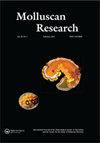Genetic variation in non-indigenous populations of the land snails Harmozica ravergiensis and Brephulopsis cylindrica (Gastropoda: Stylommatophora) in the south of the Central Russian Upland (Eastern Europe)
IF 0.6
4区 生物学
Q3 ZOOLOGY
引用次数: 0
Abstract
ABSTRACT The Caucasian snail Harmozica ravergiensis Férussac, 1835 (Gastropoda, Stylommatophora, Hygromiidae) and the Crimean snail Brephulopsis cylindrica Menke, 1828 (Gastropoda, Stylommatophora, Enidae) have been spreading across the northern borders of their ranges in recent years. Here I present a study of the variability of ISSR loci in the populations of H. ravergiensis and B. cylindrica outside their natural range, in the south of the Central Russian Upland (Belgorod Region, Russia). A comparison is made with populations of these snail species in their native area (respectively, the Caucasus and Crimea). Genetic polymorphism is generally at the same level in alien and natural populations of the species. However, in some geographically isolated alien populations, the variability indices are lower than in the native area. The level of genetic differentiation between geographically distant populations indicates different sources of invasion. A high level of genetic differentiation was also detected between native populations. No isolation by distance was found for the Belgorod populations of H. ravergiensis (Mantel test, R2=0.065; P = 0.110). The exchange of migrants between these local populations is probably occurring anthropogenically.中俄罗斯高原南部(东欧)非本地陆地蜗牛Harmozica ravergiensis和Brephulopsis ica(腹足目:柱头螺)的遗传变异
摘要:近年来,高加索蜗牛Harmozica ravergiensis f russac, 1835(腹足目,柱头虫科,湿足虫科)和克里米亚蜗牛Brephulopsis ica Menke, 1828(腹足目,柱头虫科,Enidae)在其分布范围的北部边界蔓延。在这里,我提出了一项在俄罗斯中部高地(别尔哥罗德地区,俄罗斯)南部的H. ravergiensis和B. ica种群的ISSR位点变异的研究。与这些蜗牛物种在其原产地区(分别为高加索和克里米亚)的种群进行了比较。外来居群和自然居群的遗传多态性总体上处于同一水平。然而,在一些地理上孤立的外来种群中,变异指数低于原生种群。地理距离较远的种群间的遗传分化水平表明不同的入侵来源。在本地种群之间也发现了高度的遗传分化。别尔哥罗德种群未发现距离隔离(Mantel检验,R2=0.065;p = 0.110)。这些地方人口之间的移民交换可能是人为的。
本文章由计算机程序翻译,如有差异,请以英文原文为准。
求助全文
约1分钟内获得全文
求助全文
来源期刊

Molluscan Research
生物-动物学
CiteScore
1.80
自引率
10.00%
发文量
27
审稿时长
>12 weeks
期刊介绍:
Molluscan Research is an international journal for the publication of authoritative papers and review articles on all aspects of molluscan research, including biology, systematics, morphology, physiology, ecology, conservation, biogeography, genetics, molecular biology and palaeontology.
While the scope of the journal is worldwide, there is emphasis on studies relating to Australasia and the Indo-west Pacific, including East and South East Asia. The journal’s scope includes revisionary papers, monographs, reviews, theoretical papers and briefer communications. Monographic studies of up to 73 printed pages may also be considered.
The journal has been published since 1957 (as the Journal of the Malacological Society of Australia until 1993). It is free to members of the Malacological Society of Australasia and the Society for the Study of Molluscan Diversity.
 求助内容:
求助内容: 应助结果提醒方式:
应助结果提醒方式:


